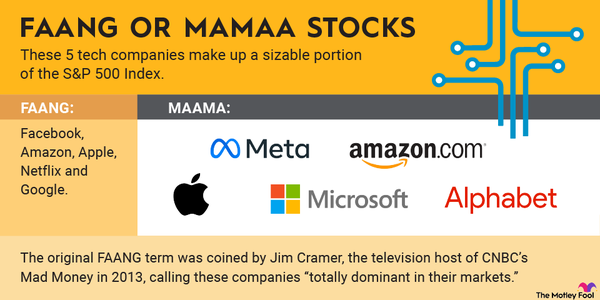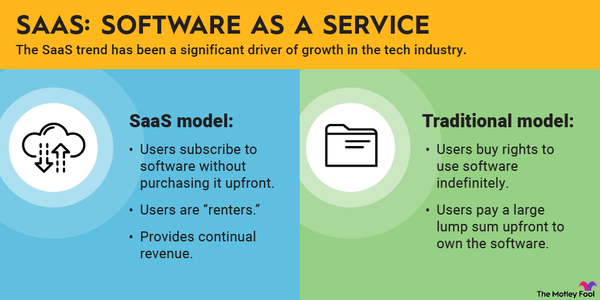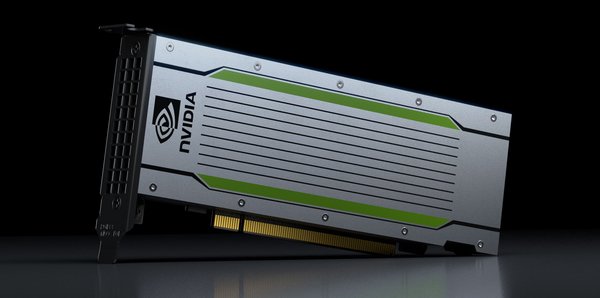The technology sector has played a leading role in powering the market's gains over the past couple of decades. New hardware, software, and services have driven changes in business and everyday life. Tech's ability to shape and influence almost every industry under the sun means the sector remains one of the best starting places for investors seeking big gains.

List of tech stocks
Eight cheap tech stocks to watch in 2025
Following bouts of market volatility over the last several years, even some otherwise high-flying growth stocks might be considered a great long-term deal right now. And for many older and slower-growing tech stocks, valuations continue to look attractive. Here are eight "cheap" tech stocks that could deliver strong returns over the long term:
1 - 4
Kyndryl is an IT services company that was spun off from IBM late in 2021. The business was separated so that IBM could focus on units that presented stronger growth opportunities, but Kyndryl has been unlocking its potential now that it's a standalone entity. It could also have some underappreciated growth catalysts on the horizon.
When the business was still part of IBM, its products and services were often sold through discounted bundles to promote other products. As a result, Kyndryl's pricing and margins were under serious pressure -- and the business recorded wide losses in its first couple years as a publicly traded company. However, the IT specialist has gotten much more selective with its contracts, focusing on deals that are directly beneficial. This strategy is transforming the margins picture for the better.
In addition to improved profitability on legacy offerings, the company has also been winning new contracts with cloud hyperscalers. Thanks to the breadth of data that Kyndryl has accumulated through its vast experience in the IT space, the company could be an undervalued artificial intelligence play.
Kyndryl is trading at a forward price-to-earnings (PE) ratio of roughly 19.5, which doesn't look particularly cheap for a business that's battling to return to sales growth. But with shares trading at roughly 11 times next year's forecast profits and signs pointing to continued earnings growth from there, the stock is attractively valued.
2. Applied Materials
Applied Materials provides the equipment needed to manufacture semiconductors. Many chip companies are cyclical, with revenue and profits ebbing and flowing with consumer and business demand.
However, Applied Materials has a much more stable growth business model. New chip fabrication plants and expansions take years of planning, and their equipment requires ongoing service -- a source of revenue for Applied, as well. The company should be able to continue growth in conjunction with the overall microchip manufacturing industry and increasing demand for network-connected industrial equipment, electric vehicles, and artificial intelligence (AI) technologies.
There's also a global push to diversify and localize the semiconductor supply chain. Governments are allocating billions of dollars to promote new manufacturing capabilities at home. This bodes well for Applied Materials.
The company consistently generates high operating profit margins and returns all of its free cash flow to shareholders via a dividend and share repurchases. The stock trades for 21 times trailing-12-month earnings -- a level that looks cheap in the context of the tech specialist's business strengths and growth opportunities.
3. Alphabet
One of the FAANG stocks (large tech companies with big competitive advantages), Alphabet has gone from high-flying internet search technologist to value-stock status. Alphabet's Google search business has emerged from pressures facing the overall digital advertising industry, and the company has returned to generating operating profit margins above 30%. It uses its profits to fund even higher-growth businesses, such as YouTube and Google Cloud, as well as emerging technologies, such as its self-driving car subsidiary Waymo.
Alphabet also had one of the largest cash and short-term investment (net of debt) balances of any public company at roughly $95 billion as of mid-2024. When paired with its strong product suite and long-term expansion potential, there's a lot to like about Alphabet -- especially with shares trading at 19 times one-year forward expected earnings.
4. AT&T
AT&T's big vision to build a multimedia empire capable of complementing its telecommunications business didn't turn out as planned. In 2021, the company spun off its DirecTV satellite television business. The following year, the telecom giant spun off the Time Warner division that it had paid $85 billion to acquire, resulting in a merger that created Warner Bros. Discovery (WBD 2.46%). Although the move reduced cash-generating capabilities and resulted in a dividend cut, the company is now leaner and more efficient and still offers a great dividend profile.
AT&T is back to focusing on telecommunications services, and it's likely in the early stages of benefiting from focusing on driving growth for its 5G and fiber-internet businesses. Mobile connectivity and high-performance internet are increasingly central to business and everyday life, and it's likely that digital connectivity will become even more important through the next decade and beyond. Even after cutting its dividend, AT&T stock boasts a 5% yield, and shares are in value territory trading at less than 10 times next year's expected earnings.
5 - 8
5. IBM
IBM, a longtime tech giant, has been in need of some major transformation in recent years. But it is indeed transforming. It is focusing its operations on cloud and hybrid-cloud computing and spun off a big chunk of its legacy operation via Kyndryl in 2021. The new IBM has returned to growth mode and reported a 3% currency-adjusted sales in 2023. It expects it can sustain a mid-single-digit revenue expansion rate over the next few years while still maintaining a high level of profitability.
IBM also pays a lucrative dividend, one it expects to be able to maintain now that it's refocusing on higher-profit cloud services. With shares sporting an above average dividend yield and reasonable price-to-free-cash-flow ratio (17 times trailing-12-month FCF) and the company's opportunities for gradual growth in emerging computing services, IBM could be a great buy for value-seeking technology investors.
6. Meta Platforms
Meta Platforms, the rebranded parent organization of Facebook, Instagram, and WhatsApp, has returned to posting impressive revenue growth now that it has emerged from pressures facing the digital advertising industry. The company has also boosted its margins thanks to a range of cost-cutting and efficiency initiatives.
As a result, the company's earnings have been soaring. While the stock has posted big gains, there are signs that the company's valuation still hasn't caught up to its improved business momentum.
Meta had a forward price-to-earnings-growth (PEG) ratio of roughly 0.6 as of September 2024. For reference, a PEG value of less than 1 is often viewed as a sign that a company is undervalued compared to its growth.
The social media titan still looks undervalued compared to many other big names in the tech sector, and there's a good chance it can outperform the market over the long term if it continues to adapt its operations.
Meta is investing heavily in AI, and these initiatives could make its developers and platforms more efficient and create improved performance for its core advertising business. As a more long-term growth initiative, the tech giant is also betting on the metaverse and virtual reality. The company thinks virtual worlds present massive growth opportunities and is willing to play the long game in developing related technologies and platforms.
With billions of users around the globe, Meta can tap into the long-term growth of digital ads and use profits to foster growth in AI, the metaverse, and other areas such as e-commerce.
7. Qualcomm
Almost every smartphone on the planet contains some sort of Qualcomm chip. As mobility expands to encompass other devices (cars, smart-home devices, industrial equipment, etc.), Qualcomm is finding new avenues for growth. Yet, largely due to a widespread belief that Apple (AAPL 0.67%) will eventually completely part ways with Qualcomm and use its own mobile chips for the iPhone and iPad, Qualcomm trades for less than many of its semiconductor industry peers.
In the fall of 2024, Qualcomm stock was valued at just 15 times trailing-12-month free cash flow. But in the next few years, the company thinks it will experience a lot more growth from new mobility chip designs. Along the way, shareholders get treated to a modest dividend yield and share repurchases to sweeten the deal.
8. Micron Technology
Micron Technology is another value stock within the semiconductor industry that at roughly seven times next year's expected earnings as of spring 2024. A giant in developing memory chips and storage solutions, this is a cyclical business that's trading at a significant discount due to uncertainty surrounding sales and pricing-power trends.
Due to the cyclical nature of the memory chip business, relying too much on Micron's price-to-earnings ratio at any given time would be a mistake because profits can fluctuate dramatically in a short period of time. However, the company is poised to continue benefiting from demand trends related to the rise of artificial intelligence.
Data center customers have been buying up Micron's memory solutions to help facilitate new AI use cases, and that's causing the company's sales to soar. While the memory specialist's business will continue to be shaped by cyclical trends, AI-related demand has emerged as a new performance driver. The company's current valuation suggests that the long-term impact of this positive catalyst is being underestimated.
Related investing topics
What to look for
What to look for in tech stocks
Investors are generally well served by keeping an eye on tech companies' sales and earnings growth, as well as valuation metrics such as price-to-sales and price-to-earnings ratios. There are many other useful stock metrics you can and should consider. For example, it's helpful to keep an eye on each company's number of active users or its customer count, plus how much per-user or per-client sales and profit a business is generating.
The technology sector encompasses a vast array of companies providing a wide range of disparate products and services. There's no reliable one-size-fits-all approach for evaluating stocks in the space, but charting business momentum and keeping intrinsic value in mind can make it easier to identify winners.

























